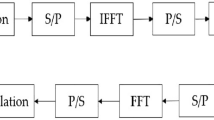Abstract
The capacity of a multicarrier code-division multiple access (MC-CDMA) system is limited by a multiple access interference (MAI) from other users. In this paper, we propose a MAI cancellation scheme to transmit images over a recent discrete sine transform (DST) based MC-CDMA (DST-MC-CDMA) system. In the proposed scheme the minimum mean square error (MMSE) equalizer is used to provide the initial estimate of users’ data and the parallel interference cancellation (PIC) scheme is then used to regenerate and cancel the MAI from the desired user. The proposed scheme is called MMSE-PIC. Simulation results in multi-path fading channel confirm the excellent performance of the proposed scheme as compared to MMSE equalization method. It is also found that the best suitable tentative decision for the proposed scheme is the null zone decision or the clipper decision. We also conduct experiments to show the performance of the proposed scheme with a real image transmission over the DST-MC-CDMA system. Results show that the proposed scheme provides significant image quality improvement as compared to the existing schemes. The average peak signal to noise ratio improvement achieved by the proposed scheme over the conventional MMSE equalizer at a SNR = 30 dB is about 6.5 dB for different number of users.
















Similar content being viewed by others
References
Hara, S., & Prasad, R. (1999). Design and performance of multicarrier CDMA system in frequency selective Rayleigh fading channels. IEEE Transactions on Vehicular Technology, 48(5), 1584–1595.
Al-kamali, F. S., Al-qasem, H. M., Saif, B. A., Albhloli, K. K., & Suliman, N. A. (2013). Multi-carrier CDMA system with different basis functions. Journal of Communications Engineering and Networks, 1(1), 19–26.
Andrews, J. G., & Meng, T. H. (2004). Performance of multicarrier CDMA with successive interference cancellation in a multipath fading channel. IEEE Transactions on Communications, 52(5), 811–822.
Miller, S. L., & Rainbolt, B. J. (2000). MMSE detection of multicarrier CDMA. IEEE Journal on Selected Areas in Communications, 18, 2356–2362.
Hesse, W., & Schulz, T. (2002). Parallel interference cancellation applied to an asynchronous MC-CDMA system. In Proceedings of the IEEE VTC2002.
Dang, P. P., & Chau, P. M. (2000). Robust image transmission over CDMA channels. IEEE Transaction on Consumer Electronics, 46(3), 664–672.
Jindal, S., & Agarwal, D. (2014). Performance evaluation of image transmission over MC-CDMA system using two interleaving schemes. In Proceedings of the ICACCI2014 (pp. 1341–1347).
El-Bakary, E. M., Hassan, E. S., Zahran, O., El-Dolil, S. A., & Abd El-Samie, F. E. (2013). Efficient image transmission with multi-carrier CDMA. Wireless Personal Communications Journal, Springer US, 69(2), 979–994.
Vishvaksenan, K. S., Natarajan, K., Sathiyarajan, M., & Vengatraman M. (2014). Performance of MIMO MC-CDMA system for DWT technique based color image transmission over correlated frequency-selective channel. In Proceedings of the ICCSP2014 Conference (pp. 528–532).
Sun, Y., & Xiong, Z. (2006). Progressive image transmission over space-time coded OFDM-based MIMO systems with adaptive modulation. IEEE Transactions on Mobile Computing, 5(8), 1016–1028.
Wang, W. (2011). Space–time coding MIMO-OFDM SAR for high-resolution imaging. IEEE Transactions on Geoscience and Remote Sensing, 49(8), 3094–3104.
Shayegannia, M., Hajshirmohammadi, A., Muhaidat, S., & Torki, M. (2013). Space–time coding MIMO-OFDM SAR for high-resolution imaging. IET Image Processing, 7(1), 33–41.
Chaudhary, S. R., & Patil, A. J. (2015). Hybrid MIMO-OFDM system with application to Image transmission. In Proceedings of the ICCICT2015 (pp. 1–5).
Al-kamali, F. S., Dessouky, M. I., Salam, B. M., & Abd El-Samie, F. E. (2009). Performance evaluation of cyclic prefix CDMA systems with frequency domain interference cancellation. Digital Signal Processing Journal, Science, Direct, 19(1), 2–13.
Rappaport, T. S. (2002). Wireless communications principles and practice (2nd ed.). New Jersey: Pearson Education.
3rd Generation Partnership Project, 3GPP TS 25.101. (2007). Technical specification group radio access network; user equipment (UE) radio transmit and reception (FDD) (Release 7), Section B.2.2.
Author information
Authors and Affiliations
Corresponding author
Rights and permissions
About this article
Cite this article
Al-Junaid, A.F., Al-kamali, F.S. Efficient wireless transmission scheme based on the recent DST-MC-CDMA. Wireless Netw 22, 813–824 (2016). https://doi.org/10.1007/s11276-015-0990-4
Published:
Issue Date:
DOI: https://doi.org/10.1007/s11276-015-0990-4




